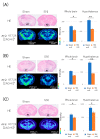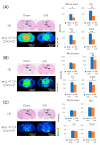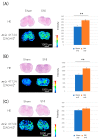Expression and Kinetics of Endogenous Cannabinoids in the Brain and Spinal Cord of a Spare Nerve Injury (SNI) Model of Neuropathic Pain
- PMID: 36552893
- PMCID: PMC9776457
- DOI: 10.3390/cells11244130
Expression and Kinetics of Endogenous Cannabinoids in the Brain and Spinal Cord of a Spare Nerve Injury (SNI) Model of Neuropathic Pain
Abstract
The role of endogenous cannabinoids in neuropathic pain has been actively studied, among which 2-arachidonoyl glycerol (2-AG) has received the most attention. However, owing to its chemical properties, direct detection of 2-AG distribution in tissues is difficult. Moreover, although desorption electrospray ionization mass spectrometry imaging (DESI-MSI) has enabled the detection of 2-AG, its distribution in the brain and spinal cord of neuropathic pain models has not been reported. In this study, the expression and distribution of 2-AG in the brain and spinal cord of a spare nerve injury (SNI) mice model of neuropathic pain was examined using DESI-MSI. The brain and lumbar spinal cord were collected and analyzed on days 3, 7, and 21 after treatment. On days 3 and 7 after treatment, 2-AG expression in the SNI model was decreased in the hypothalamus, midbrain, and especially in the periaqueductal gray (PAG) region but increased in the lumbar spinal cord. On day 21, the SNI model showed decreased 2-AG expression in the hypothalamus, but the difference from the control was not significant. Furthermore, there were no differences in 2-AG expression between the lumbar spinal cord, midbrain, or PAG. These data suggest that 2-AG might be involved in pain control.
Keywords: 2-arachidonoyl glycerol; DESI-MSI; endogenous cannabinoids; hypothalamus; lumbar spinal cord; periaqueductal gray; spare nerve injury.
Conflict of interest statement
The authors declare no conflict of interest.
Figures




Similar articles
-
Microglial BDNF, PI3K, and p-ERK in the Spinal Cord Are Suppressed by Pulsed Radiofrequency on Dorsal Root Ganglion to Ease SNI-Induced Neuropathic Pain in Rats.Pain Res Manag. 2019 Apr 28;2019:5948686. doi: 10.1155/2019/5948686. eCollection 2019. Pain Res Manag. 2019. PMID: 31182984 Free PMC article.
-
Upregulation of Chemokine CXCL12 in the Dorsal Root Ganglia and Spinal Cord Contributes to the Development and Maintenance of Neuropathic Pain Following Spared Nerve Injury in Rats.Neurosci Bull. 2016 Feb;32(1):27-40. doi: 10.1007/s12264-015-0007-4. Epub 2016 Jan 19. Neurosci Bull. 2016. PMID: 26781879 Free PMC article.
-
Region-specific deletions of the glutamate transporter GLT1 differentially affect nerve injury-induced neuropathic pain in mice.Glia. 2018 Sep;66(9):1988-1998. doi: 10.1002/glia.23452. Epub 2018 May 3. Glia. 2018. PMID: 29722912
-
Electroacupuncture Treatment Suppresses Transcription Factor IRF8 in Spinal Cord of Rats with Spared Nerve Injury.Pain Res Manag. 2020 Apr 10;2020:1854363. doi: 10.1155/2020/1854363. eCollection 2020. Pain Res Manag. 2020. PMID: 32351637 Free PMC article.
-
Nerve injury evoked loss of latexin expression in spinal cord neurons contributes to the development of neuropathic pain.PLoS One. 2011 Apr 29;6(4):e19270. doi: 10.1371/journal.pone.0019270. PLoS One. 2011. PMID: 21572518 Free PMC article.
Cited by
-
Sample Preparation Method for MALDI Mass Spectrometry Imaging of Fresh-Frozen Spines.Anal Chem. 2023 Nov 28;95(47):17337-17346. doi: 10.1021/acs.analchem.3c03672. Epub 2023 Oct 27. Anal Chem. 2023. PMID: 37886878 Free PMC article.
References
-
- Mechoulam R., Ben-Shabat S., Hanus L., Ligumsky M., Kaminski N.E., Schatz A.R., Gopher A., Almog S., Martin B.R., Compton D.R. Identification of an endogenous 2-monoglyceride, present in canine gut, that binds to cannabinoid receptors. Biochem. Pharmacol. 1995;50:83–90. doi: 10.1016/0006-2952(95)00109-D. - DOI - PubMed
-
- Altamura C., Ventriglia M., Martini M.G., Montesano D., Errante Y., Piscitelli F., Scrascia F., Quattrocchi C., Palazzo P., Seccia S., et al. Elevation of Plasma 2-Arachidonoylglycerol Levels in Alzheimer’s Disease Patients as a Potential Protective Mechanism against Neurodegenerative Decline. J. Alzheimer’s Dis. 2015;46:497–506. doi: 10.3233/JAD-142349. - DOI - PubMed
Publication types
MeSH terms
Substances
LinkOut - more resources
Full Text Sources

